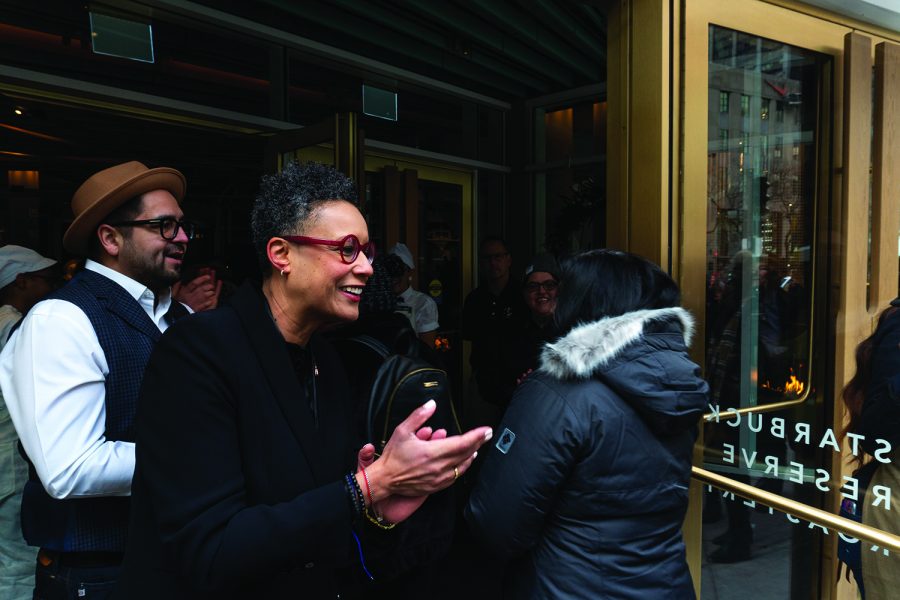World’s largest Starbucks finds home on Magnificent Mile
November 18, 2019
The aroma of several different coffee brews, liquid nitrogen gelato and whiskey barrel-aged cold brew waft throughout the Chicago Reserve Roastery as a network of tubes pump freshly roasted coffee beans.
The Starbucks Reserve Roastery, 646 N. Michigan Ave., is a coffee lover’s paradise. With its grand opening Friday, Nov. 15, this location is the sixth of its kind in the world—after Seattle, Shanghai, Milan, New York and Tokyo. But at 35,000 square feet, the Chicago location is the largest Starbucks in the world.
The five-story roastery opened its doors at 9 a.m. with a warm reception to the guests standing in a line that wrapped around the block—many of whom had waited for several hours in the cold.
Cindy Aguilar and Emilio Pilapio arrived at 5 a.m. to be the first and second in line. Pilapio said he had planned two months in advance for the opening.
Aguilar said she was excited for all the features exclusive to the Chicago Reserve Roastery—the coffee roasted in-house, specialty cocktails, Italian pastries at the Princi artisanal bakery and unique merchandise designed by Chicago artist Mac Blackout.
“It’s a once in a lifetime experience,” Pilapio said. “No one else can really say, ‘I was second in line [at] the world’s largest Starbucks grand opening.’”
When the doors opened, the roastery’s General Manager Shauna McKenzie-Lee greeted guests. Also present was Starbucks CEO Kevin Johnson, who handed out free espressos at one of the three coffee bars inside.
On the first floor of the roastery sits a large bronze-colored coffee bean roaster—which is actually smaller than a traditional roaster, said Marc Wanless, director of operations, who oversees roasting at the six large-scale locations worldwide.
“All the coffee that we roast here is for use right here within the four walls of our Chicago Roastery,” Wanless said.
While the coffee is roasted and used in-house, it is sourced from Guatemala, Brazil, Hawaii, Kenya and other countries.
Not all those standing outside were in line for the festivities, though. Jonathan Horn, an advocate with People for the Ethical Treatment of Animals, was in attendance to protest Starbucks’ upcharge on vegan milk options. Most U.S. Starbucks locations charge extra for soy, almond and coconut milk alternatives in drinks but many coffee chains, such as Tim Hortons, have stopped this practice.
“They shouldn’t be penalizing people for caring about animal cruelty as well as the environment and their health,” Horn said.
Starbucks said it chose Chicago as the site for its largest retail location because the city was instrumental in its success early on, according to a Nov. 13 press release. In 1987, Starbucks opened its first store outside of the Pacific Northwest in Chicago, which helped the coffee chain expand nationwide.
The grand opening of the roastery comes after Starbucks’ recent investment of $10 million in Community Development Financial Institutions in Chicago, such as Accion Chicago, Chicago Community Loan Fund, Local Initiative Support Corporation and IFF. The investment will be divided into 500 loans that will be used to finance community development projects, support small businesses and generate “the economic vitality” in underserved communities, according to the roastery’s website.
Jackie Blair, manager of marketing and communications at Accion Chicago, said her organization’s portion of that investment will be used to distribute more capital to entrepreneurs chiefly on the South and West sides. Blair said the focus is on providing loans to those in underserved areas who might find it otherwise difficult to finance their small businesses, as well as to use Starbucks’ investment for economic development citywide.
Marcus Yancey, in Economic Development Lending Officer for the Local Initiative Support Corporation, expressed a similar sentiment. He said the investment will be used by his organization for lending allocated capital to small businesses and community organizations, which he hopes creates jobs and curbs violence in some of the neighborhoods.
Juan Calixto, vice president of external relations for Chicago Community Loan Fund, said his organization will use its portion of the funds for commercial real estate investments on the city’s South and West sides as well.
“This investment from Starbucks is saying to those neighborhoods, ‘Yes, we’re opening up a store on Michigan Avenue, but we also care about what’s happening on your block,'” he said.








